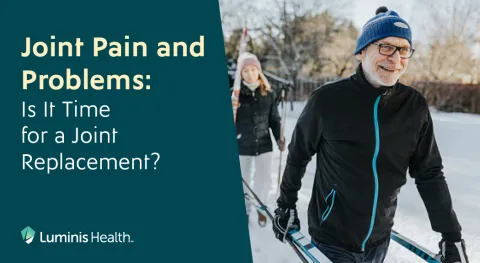by Luminis Health

Living with arthritis can be distracting and difficult—quite literally a pain. More than 50 million people in the United States have some form of arthritis, with osteoarthritis, the most common form of arthritis, found in nearly 27 million.
While the risk for developing osteoarthritis increases with age, there can be other contributing factors, such as:
- Previous joint injury;
- Certain infections in the joint;
- Occupations that involve a lot of squatting and bending of the knee; and
- Obesity.
Here are six steps you can take that can make the difference between coping and living well with the pain from osteoarthritis:
Maintain a Healthy Weight
Did you know for every pound you lose, you take three pounds of force off your joints? Ease your pain by maintaining a healthy weight. Plus, excess weight can speed the progression of knee osteoarthritis.
Adjust Your Diet
In some cases your diet can help with inflammation that can cause joint pain. There are foods, like those with omega-3 fatty acids that can be beneficial. Also, cutting back on fried and processed foods can help reduce inflammation.
Get Ample Sleep, But Watch the Naps
If you’re having trouble sleeping, cutting caffeine and alcohol can help, too. Lack of sleep is a vicious cycle where pain keeps you awake and then sleeplessness leads to more fatigue and pain. Avoid naps and cut electronics before bed to help ensure a more restful night’s sleep.
Stay Active
Good nutrition, ample sleep and regular exercise are key to helping you live well with joint pain. You’ll be inclined to stop being active, but you must resist. Regular exercise helps maintain joint function while relieving stiffness and fatigue. Strong muscles help support your joints. Work with your doctor to determine the best exercise for your lifestyle and needs. Walking, swimming, yoga or resistance training are often good places to start.
Know What Doesn’t Work
Don’t be fooled by claims not backed by science. Two of the more common ones I hear from patients are that taking glucosamine or wearing a copper bracelet helps with joint pain. Neither has been shown effective for treating arthritis pain, so please save your money.
Partner With Your Doctor
Living well with pain isn’t easy, but it helps to have your doctor as your partner. Your doctor can help you diagnose the cause of the pain and develop strategies to improve your mobility. Often your doctor will start with conservative treatments, such as prescribing anti-inflammatories, cortisone injections, braces, or physical therapy. If you don’t respond to those treatments, your doctor can connect you with the latest advances in joint care.
Originally published March 2015. Last updated August 2018.



